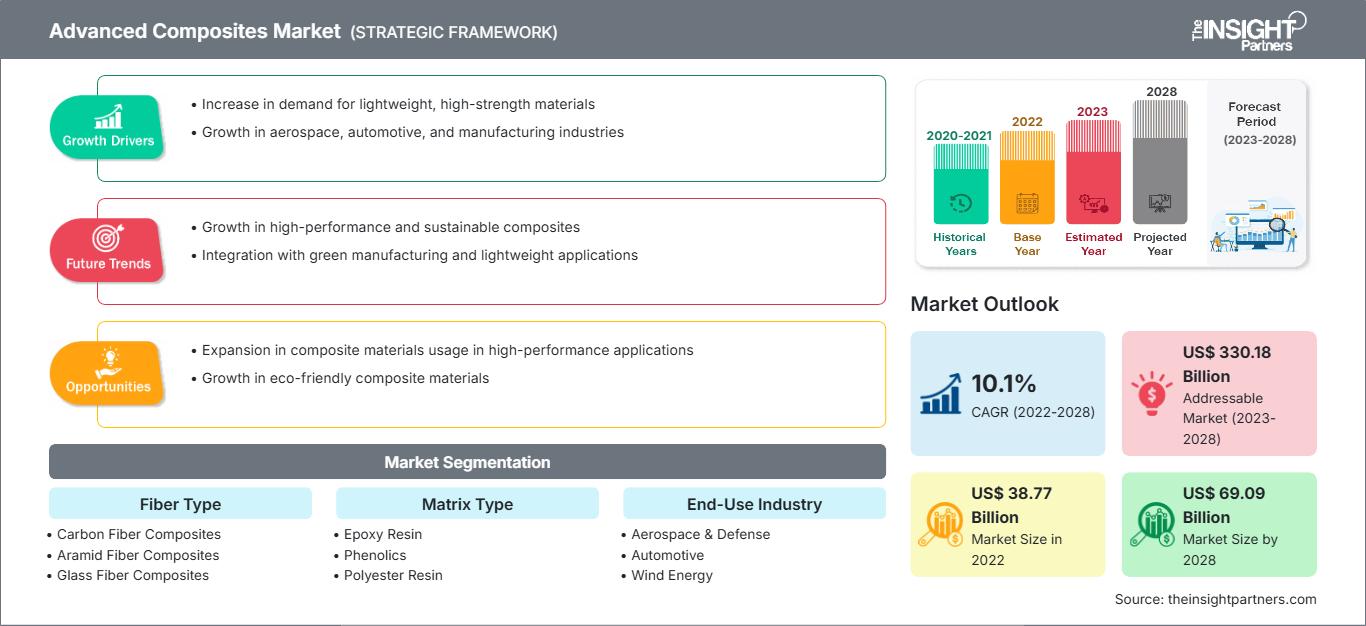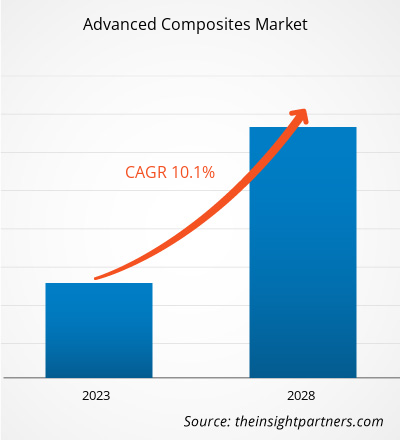[Forschungsbericht]Der Markt für fortschrittliche Verbundwerkstoffe wurde im Jahr 2022 auf 38.772,87 Millionen US-Dollar geschätzt und soll bis 2028 69.092,18 Millionen US-Dollar erreichen; von 2022 bis 2028 wird ein durchschnittliches jährliches Wachstum von 10,1 % erwartet.
Hochleistungsverbundwerkstoffe sind Materialien mit hoher Strukturfestigkeit, die durch die Kombination einer oder mehrerer steifer, hochfester Verstärkungsfasern mit einem kompatiblen Harzsystem hergestellt werden. Fortschrittliche Verbundwerkstoffe werden in vielen Strukturanwendungen als Ersatz für Metalle und Holzverbundwerkstoffe eingesetzt. Fortschrittliche Verbundwerkstoffe umfassen Strukturmaterialien, die für hochtechnologische Anwendungen wie Automobil-, Flugzeug- und Windkraftstrukturen entwickelt wurden, für die andere Materialien nicht steif genug sind. In diesen Materialien sind steife und starke kontinuierliche oder diskontinuierliche Fasern, Whisker oder kleine Partikel in der Matrix verteilt. Verschiedene Fasern, darunter Metalle, Kohlenstoff, Keramik, Glas und Polymere, werden in großem Umfang bei der Herstellung moderner Verbundwerkstoffe verwendet.
Die steigende Nachfrage nach Leichtbauwerkstoffen in der Luft- und Raumfahrt- sowie Verteidigungsindustrie treibt das Wachstum des Marktes für moderne Verbundwerkstoffe voran. Der Bedarf an Kraftstoffeinsparung und -effizienz hat Leichtbauwerkstoffe in der Transportindustrie in den Vordergrund gerückt. Darüber hinaus werden moderne Verbundwerkstoffe zunehmend in der Windenergie-, Automobil- und Bauindustrie eingesetzt. Darüber hinaus wird erwartet, dass die zunehmende Verwendung von Bioverbundwerkstoffen das Wachstum des Marktes für moderne Verbundwerkstoffe im Prognosezeitraum ankurbeln wird.
Der Markt für moderne Verbundwerkstoffe ist in fünf Hauptregionen unterteilt: Nordamerika, Europa, Asien-Pazifik, Naher Osten und Afrika sowie Süd- und Mittelamerika. Im Jahr 2022 hatte Europa den größten Marktanteil, und der Asien-Pazifik-Raum wird im Prognosezeitraum voraussichtlich die höchste durchschnittliche jährliche Wachstumsrate verzeichnen. Die hohe Nachfrage nach modernen Verbundwerkstoffen aus der Automobil-, Luft- und Raumfahrt- und Verteidigungsindustrie sowie der Bauindustrie unterstützt das Wachstum des europäischen Marktes für moderne Verbundwerkstoffe. Darüber hinaus ist der Asien-Pazifik-Raum, die bevölkerungsreichste Region der Welt, Standort einer der am schnellsten wachsenden Bau- und Automobilindustrien der Welt. Dieser Faktor trägt zur hohen Nachfrage nach modernen Verbundwerkstoffen in der Region bei.
Passen Sie diesen Bericht Ihren Anforderungen an
Sie erhalten kostenlos Anpassungen an jedem Bericht, einschließlich Teilen dieses Berichts oder einer Analyse auf Länderebene, eines Excel-Datenpakets sowie tolle Angebote und Rabatte für Start-ups und Universitäten.
Markt für fortschrittliche Verbundwerkstoffe: Strategische Einblicke

-
Holen Sie sich die wichtigsten Markttrends aus diesem Bericht.Dieses KOSTENLOSE Beispiel umfasst Datenanalysen, die von Markttrends bis hin zu Schätzungen und Prognosen reichen.
Auswirkungen der COVID-19-Pandemie auf den Markt für fortschrittliche Verbundwerkstoffe
Vor der COVID-19-Pandemie wurde der Markt für fortschrittliche Verbundwerkstoffe hauptsächlich von Branchen wie der Automobilindustrie, dem Baugewerbe, der Luft- und Raumfahrt & Verteidigung, der Windenergie und der Schifffahrt getrieben. Im Jahr 2020 mussten verschiedene Branchen ihre Betriebsabläufe aufgrund von Unterbrechungen der Lieferketten infolge der Schließung nationaler und internationaler Grenzen drosseln. Die Pandemie behinderte die Herstellungsprozesse aufgrund von Beschränkungen, die von Regierungsbehörden in verschiedenen Ländern verhängt wurden. Fortschrittliche Verbundwerkstoffe finden wichtige Anwendungen in der Luft- und Raumfahrt- & Verteidigungs- sowie der Automobilindustrie, wo sie zur Gewichtskontrolle von Fahrzeugen und zur Kraftstoffsteuerung eingesetzt werden. Auch im Bausektor werden sie häufig verwendet. Mit dem Rückgang der Aktivitäten in diesen Sektoren sank daher auch die Nachfrage nach fortschrittlichen Verbundwerkstoffen. Die Pandemie verursachte zudem Schwankungen bei den Rohstoffpreisen. All diese Faktoren führten zu einem Rückgang der Nachfrage nach fortschrittlichen Verbundwerkstoffen. Im Jahr 2021 begann sich die Wirtschaft jedoch zu erholen, da verschiedene Branchen ihre Geschäftstätigkeit wieder aufnahmen. Infolgedessen zeigten mehrere Branchen, darunter die Luft- und Raumfahrt & Verteidigung, die Automobilindustrie sowie das Baugewerbe, Anzeichen einer Erholung ihrer Geschäftstätigkeit. Verschiedene Branchen überwinden zudem die Folgen von Störungen in ihren Rohstofflieferketten. Mit einer solch vielversprechenden Erholung wird erwartet, dass der globale Industriesektor in den kommenden Jahren Impulse für das Wachstum des Marktes für fortschrittliche Verbundwerkstoffe geben wird.
Markteinblicke
Strategische Entwicklungen wichtiger Akteure begünstigen das Wachstum des Marktes für fortschrittliche Verbundwerkstoffe
Wichtige Marktakteure verfolgen Strategien wie Fusionen und Übernahmen, um ihre geografische Präsenz auszubauen. Im April 2022 gab die Avient Corporation die Übernahme von DSM Protective Materials bekannt, um deren Marke Dyneema und deren einzigartige Technologien zu Avient hinzuzufügen. Ziel dieser Übernahme war die Erweiterung des wachsenden Verbundwerkstoffportfolios. Die Avient Corporation kündigte außerdem an, Verkaufsmöglichkeiten für ihr Avient Distribution-Geschäft zu prüfen. Solche strategischen Entwicklungen wichtiger Akteure dürften das Marktwachstum für moderne Verbundwerkstoffe in den kommenden Jahren ankurbeln.
Einblicke in die Endverbrauchsbranche
Basierend auf der Endverbrauchsbranche ist der Markt für moderne Verbundwerkstoffe in die Bereiche Luft- und Raumfahrt & Verteidigung, Automobilindustrie, Windenergie, Bauwesen, Elektrotechnik & Elektronik und Sonstige unterteilt. Der Bereich Windenergie wird im Prognosezeitraum voraussichtlich die höchste durchschnittliche jährliche Wachstumsrate (CAGR) verzeichnen. Die Nachfrage nach modernen Verbundwerkstoffen steigt im Windenergiesegment aufgrund des zunehmenden Bedarfs an größeren Turbinenblättern zur Energieerzeugung. Faktoren wie das geringere Gewicht als bei metallischen Strukturen, die Fähigkeit, sich schneller zu drehen und Winde mit geringerer Geschwindigkeit einzufangen, eine längere Lebensdauer der Blätter, Korrosionsbeständigkeit und geringere Wartungskosten haben moderne Verbundwerkstoffe zu einem entscheidenden Material gemacht, das wirtschaftliche Lösungen für große Energieerzeugungsprojekte ermöglicht. Die rasante Entwicklung der Materialtechnologie ermöglicht weiterhin Variationen in der Struktur von Windturbinen. Viele dieser Variationen wurden in erster Linie eingeführt, um die Preise der Turbinen zu senken. Faktoren wie Korrosionsbeständigkeit, Ermüdungsbeständigkeit, Zähigkeit, Steifigkeit, Gewicht und Aussehen von Windkraftanlagen haben erheblichen Einfluss auf deren Betrieb. Darüber hinaus ist glasfaserverstärkter Kunststoff (GFK) der am häufigsten verwendete Verbundwerkstoff im Windkraftanlagenbau.
Matrixtypbasierte Erkenntnisse
Basierend auf dem Matrixtyp ist der Markt für fortschrittliche Verbundwerkstoffe in Epoxidharz, Phenole, Polyesterharz, Polyurethanharz, Polyphenylensulfid (PPS), Polyetherimid (PEI) und andere unterteilt. Das Segment Epoxidharz dominierte den Markt im Jahr 2022. Epoxidharze verfügen über eine überlegene mechanische Festigkeit und Ermüdungsfestigkeit, wodurch sie feuchtigkeits-, stoß- und chemikalienbeständig sowie unter Aushärtungsbedingungen beständig sind. Epoxidharze binden faserverstärkten Kunststoff (FRP) und sind mit allen Verstärkungsfasern kompatibel, einschließlich Glasfaser, Aramid, Kohlefaser und Basalt.
Avient Corp, Toray Industries Inc, Teijin Ltd, Mitsubishi Chemical Corp, SGL Carbon SE, Owens Corning, Solvay SA, Johns Manville Corp, Tecnaro GmbH und Ensinger GmbH gehören zu den wichtigsten Akteuren auf dem Markt für Verbundwerkstoffe. Diese Unternehmen konzentrieren sich hauptsächlich auf Produktinnovationen, um ihren Marktanteil auszubauen und neue Markttrends zu verfolgen.
Verbundwerkstoffe
Regionale Einblicke in den Markt für fortschrittliche VerbundwerkstoffeDie Analysten von The Insight Partners haben die regionalen Trends und Faktoren, die den Markt für Verbundwerkstoffe im Prognosezeitraum beeinflussen, ausführlich erläutert. In diesem Abschnitt werden auch die Marktsegmente und die geografische Lage in Nordamerika, Europa, dem asiatisch-pazifischen Raum, dem Nahen Osten und Afrika sowie Süd- und Mittelamerika erörtert.
Umfang des Marktberichts zu fortschrittlichen Verbundwerkstoffen
| Berichtsattribut | Einzelheiten |
|---|---|
| Marktgröße in 2022 | US$ 38.77 Billion |
| Marktgröße nach 2028 | US$ 69.09 Billion |
| Globale CAGR (2022 - 2028) | 10.1% |
| Historische Daten | 2020-2021 |
| Prognosezeitraum | 2023-2028 |
| Abgedeckte Segmente |
By Fasertyp
|
| Abgedeckte Regionen und Länder |
Nordamerika
|
| Marktführer und wichtige Unternehmensprofile |
|
Dichte der Marktteilnehmer für fortschrittliche Verbundwerkstoffe: Verständnis ihrer Auswirkungen auf die Geschäftsdynamik
Der Markt für Verbundwerkstoffe wächst rasant. Die steigende Nachfrage der Endverbraucher ist auf Faktoren wie veränderte Verbraucherpräferenzen, technologische Fortschritte und ein stärkeres Bewusstsein für die Produktvorteile zurückzuführen. Mit der steigenden Nachfrage erweitern Unternehmen ihr Angebot, entwickeln Innovationen, um den Bedürfnissen der Verbraucher gerecht zu werden, und nutzen neue Trends, was das Marktwachstum weiter ankurbelt.

- Holen Sie sich die Markt für fortschrittliche Verbundwerkstoffe Übersicht der wichtigsten Akteure
Berichts-Spotlights
- Fortschrittliche Branchentrends im Markt für fortschrittliche Verbundwerkstoffe, die Unternehmen bei der Entwicklung effektiver langfristiger Strategien unterstützen
- Geschäftswachstumsstrategien von Marktteilnehmern in Industrie- und Entwicklungsländern
- Quantitative Analyse des Marktes für fortschrittliche Verbundwerkstoffe von 2020 bis 2028
- Schätzung der weltweiten Nachfrage nach fortschrittlichen Verbundwerkstoffen
- Porters Fünf-Kräfte-Analyse zur Veranschaulichung der Wirksamkeit von Käufern und Lieferanten in der Branche der fortschrittlichen Verbundwerkstoffe
- Jüngste Entwicklungen zum Verständnis des wettbewerbsorientierten Marktszenarios
- Markttrends und -aussichten sowie Faktoren, die das Wachstum des Marktes für fortschrittliche Verbundwerkstoffe vorantreiben und hemmen
- Unterstützung im Entscheidungsprozess durch Hervorhebung von Marktstrategien, die das kommerzielle Interesse untermauern
- Größe des Marktes für fortschrittliche Verbundwerkstoffe an verschiedenen Knotenpunkten
- Detaillierte Übersicht und Segmentierung des Marktes und der Wachstumsdynamik der fortschrittlichen Verbundwerkstoffe Branche
- Größe des Marktes für fortschrittliche Verbundwerkstoffe in verschiedenen Regionen mit vielversprechenden Wachstumschancen
- Historische Analyse (2 Jahre), Basisjahr, Prognose (7 Jahre) mit CAGR
- PEST- und SWOT-Analyse
- Marktgröße Wert/Volumen – Global, Regional, Land
- Branchen- und Wettbewerbslandschaft
- Excel-Datensatz
Aktuelle Berichte
Erfahrungsberichte
Grund zum Kauf
- Fundierte Entscheidungsfindung
- Marktdynamik verstehen
- Wettbewerbsanalyse
- Kundeneinblicke
- Marktprognosen
- Risikominimierung
- Strategische Planung
- Investitionsbegründung
- Identifizierung neuer Märkte
- Verbesserung von Marketingstrategien
- Steigerung der Betriebseffizienz
- Anpassung an regulatorische Trends






















 Kostenlose Probe anfordern für - Markt für fortschrittliche Verbundwerkstoffe
Kostenlose Probe anfordern für - Markt für fortschrittliche Verbundwerkstoffe